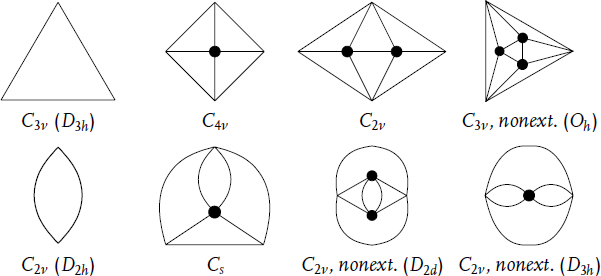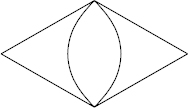14.4 Classification of Elementary ({2, 3}, 4)-Polycycles
Theorem 14.4 Any elementary ({2, 3},4)-polycycle is one of the following eight:

Proof. The list of elementary ({3},4)simp-polycycles is determined in [3] and consists of the first four graphs of this theorem. Let P be a ({2, 3}, 4)-polycycle containing a 2-gon. If|F1| = 1, then it is the 2-gon. Clearly, the case where two 2-gons share one edge is impossible. Assume that P contains two 2-gons that share a vertex. Then we should add a triangle on both sides and thus obtain the second polycycle given above. If there is a 2-gon that does not share a vertex with a 2-gon, then P contains the following pattern:

Thus, clearly, P is one of the last two possibilities above.
Note that the seventh and fourth polycycles in Theorem 14.4 are, respectively, 2- and 3-antiprisms; here the exterior face is the unique hole. The m-antiprism for any m ≥ 2 can also be seen as a ({2, 3}, 4)-polycycle with F2 consisting of the exterior and interior m-gons; this polycycle is not elementary.
Get Analysis of Complex Networks now with the O’Reilly learning platform.
O’Reilly members experience books, live events, courses curated by job role, and more from O’Reilly and nearly 200 top publishers.

